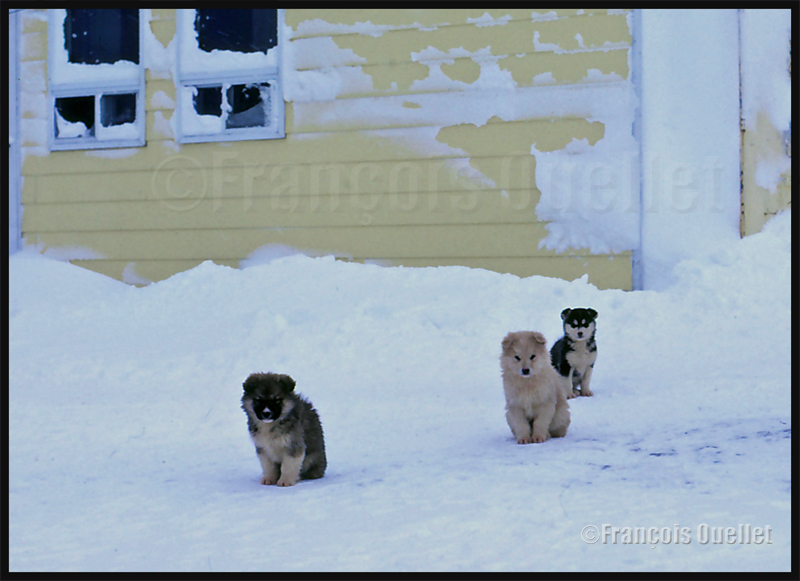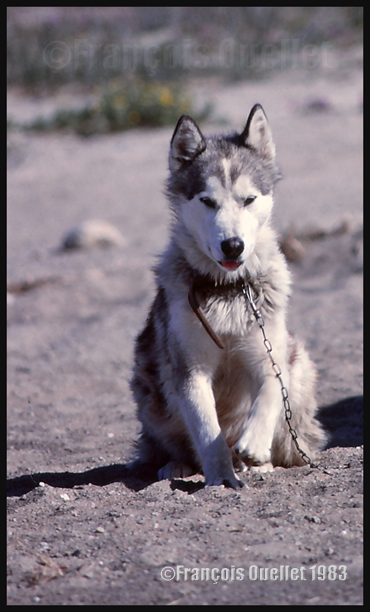(Precedent story: acquisition of an Inuit sculpture in Inukjuak in 1982)
When I was working in Inukjuak (CYPH) in Northern Quebec as a flight service specialist (FSS) for Transport Canada, in 1982-1983, I liked walking along the Hudson Bay coast. One day, I got for company a big Canadian eskimo dog belonging to an Environment Canada employee. The dog had found a way to free itself from its leash and I took advantage of his company to explore the coast.
It was not and still isn’t frequent to witness unattended dogs on a territory inhabited by Inuits. During summer, the latter normally carry the dogs on nearby isolated islands along the Hudson Bay and Ungava coasts. Naturally, the Inuits come back at regular intervals to feed them. This was still going on in 2013 as it serves multiple useful purposes. According to an Inukjuak Inuit with whom I was discussing recently, the island allows the dogs some freedom of movement since they don’t need to be tied all day long to a short rope. Also, the dogs are more comfortable on the islands since there is far less mosquitoes.
In 1982, I heard rumors according to the fact that dogs left free might be brought down, but I did not witness such a thing. Local policy was such that stray dogs would not be tolerated because they presented a threat for the population. Of all that has been said concerning dogs that were brought down for the most diverse reasons, the recurrent story is the allegation of massacres of Eskimo dogs during the fifties and sixties. The documentation found in this respect states that about one thousand dogs were brought down during those two decades, most pointlessly, in the various villages along Hudson Bay, Ungava Bay and Davis Strait.
An interim report about the investigation on this subject was handed in 2009 to the Makivik Corporation and to the Government of Quebec by the retired judge Jean-Jacques Croteau from the Quebec Superior Court. We learn of this report that the RCMP as much as Sûreté du Québec police forces had participated in the elimination of sled dogs during those years, by interpreting in a personal and fairly restrictive way a law dating from 1941 and dealing with “The Agricultural Abuses Act“. When it was created, this text of law aimed at creating a system of non-responsibility for a person who would shoot down a stray dog according to specific conditions stipulated in the text of law. Reference was made here to actions taken against stray dogs attacking sheeps and farm animals.
The police quickly made excessive use of this section of the law to apply it on a territory which was not targeted by the law. I can make a mistake, but I believe that nobody ever observed an Inuit sheep farmer on a farm in the Arctic. The most important events occurred after the RCMP gave back the responsibility of the territory to the Sûreté du Québec. That police force showed a complete misunderstanding of the Inuit culture. According to the proofs presented in the report, policemen arrived in a village without warning and killed stray dogs, chasing them even under houses, without having taken care of verifying if the dog was sick or dangerous. We find in the report the testimony of two Kangiqsujuaq Inuits asserting having seen two policemen arriving by seaplane, and without saying a word to whoever it is, begin to chase stray dogs through the village. Thirty two animals were eliminated and the policemen left the village without giving explanations.
The report states that the Northern Quebec Inuits were never consulted as to the impact of the law on “The Agricultural Abuses Act”, a totally inappropriate law for them, not taking into account their ancestral rights. The Inuits depended completely on dogs for transportation, to go hunting and fishing. We can read the following passage, in the last sections of the report: “after 1960, the actions and the behavior of the police force went too far. Nothing was to be understood. The officers demonstrated a total lack of consciousness with regard to the fundamental rights of the Inuits, their culture and the importance of dogs for their subsistence. The behavior of the officers, which could not be ignored by the provincial and federal civil administrations, had a damaging effect on seventy-five dog owners and their family, compromising their capacity to meet their needs in food “. No help was offered by the authorities to compensate for the loss of dogs.
The judge finally noted that he had no other choice than to declare that Canada and Quebec did not respect their fiduciary obligations towards the Inuits. I imagine that monetary compensations have since been offered, unless this report was only the first step in the process aimed at establishing the responsibilities and some future compensation.
(Next story: the UFO invented in Inukjuak in 1983)
For more real life stories of a FSS in Inukjuak, click on the following link: Flight service specialist (FSS) in Inukjuak

